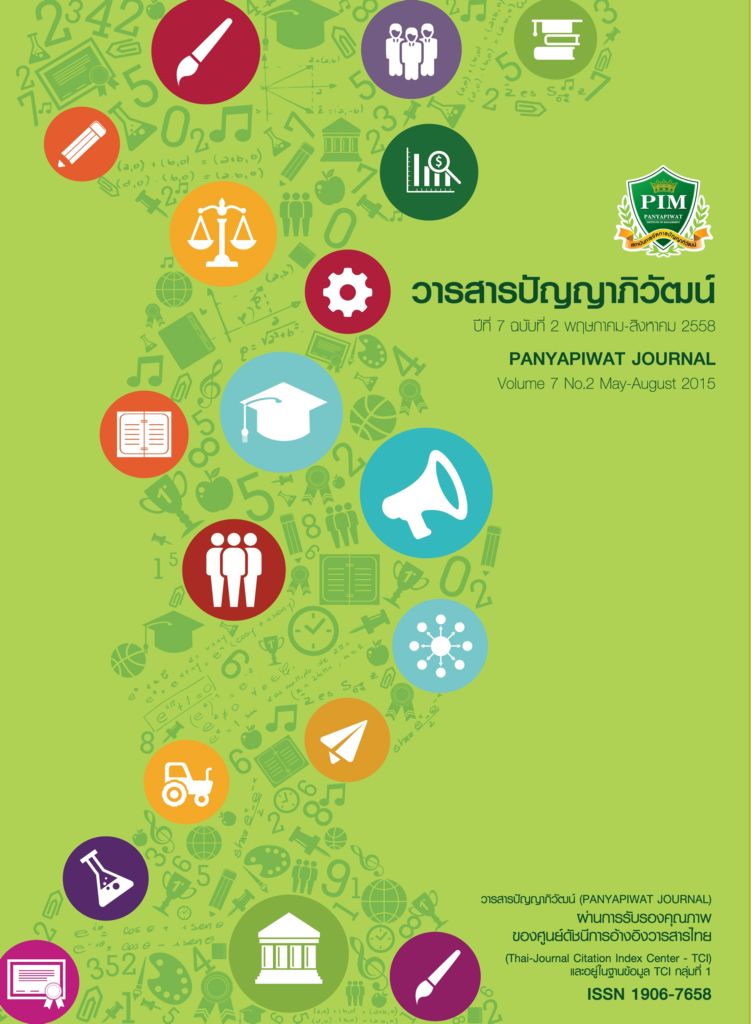กองทรัพย์สินลูกหนี้ในคดีล้มละลาย
Main Article Content
บทคัดย่อ
บทคัดย่อ
กองทรัพย์สินของลูกหนี้ในคดีล้มละลาย ได้แก่ ทรัพย์สินต่างๆ ของลูกหนี้ที่จะต้องถูกรวบรวมไว้เพื่อจัดสรร
ชำระหนี้ให้แก่เจ้าหนี้ทั้งหลาย ดังนั้นขอบเขตและขนาดของกองทรัพย์สินย่อมมีความสำคัญต่อทั้งเจ้าหนี้และลูกหนี้เพราะมันส่งผลกระทบต่อเจ้าหนี้ในการที่จะได้รับการชำระหนี้อย่างเต็มที่และเป็นธรรมแต่ในขณะเดียวกันก็ส่งผลกระทบต่อลูกหนี้ในการที่จะสามารถฟื้นตัวขึ้นมาใหม่ได้มากเพียงใด ด้วยเหตุนี้ การกำหนดขอบเขตและขนาดของกองทรัพย์สินให้เหมาะสมและสอดคล้องกับแนวคิดของกฎหมายล้มละลาย ไม่เพียงแต่จะทำให้เกิดความเป็นธรรมต่อเจ้าหนี้ ลูกหนี้ หรือผู้มีส่วนได้เสียอื่นๆ แต่ยังทำให้เกิดประสิทธิภาพและประโยชน์สูงสุดในคดีล้มละลาย ตลอดจนเป็นการสนับสนุนระบบเศรษฐกิจอีกทางหนึ่งด้วย
Abstract
Property of the estate in bankruptcy case is composed of all of a debtor’s legal and equitable interests in property which will be collected to divide to all creditors. Therefore, the scope of estate property is important for both the creditor and the debtor because it has effect on the creditor to receive payment with fully and fairly, while it has effect on how far the debtor can rehabilitate too.
Whereas, it is deemed beneficial to arrange the scope of estate property which is proper and compatible with the concept in the bankruptcy law will not only be fair to all creditors and other interested persons, including the debtor, but will also allow the overall effective and beneficial in the bankruptcy case which in turn will support economic system as well.
Article Details
“ข้าพเจ้าและผู้เขียนร่วม (ถ้ามี) ขอรับรองว่า บทความที่เสนอมานี้ยังไม่เคยได้รับการตีพิมพ์และไม่ได้อยู่ระหว่างกระบวนการพิจารณาลงตีพิมพ์ในวารสารหรือแหล่งเผยแพร่อื่นใด ข้าพเจ้าและผู้เขียนร่วมยอมรับหลักเกณฑ์การพิจารณาต้นฉบับ ทั้งยินยอมให้กองบรรณาธิการมีสิทธิ์พิจารณาและตรวจแก้ต้นฉบับได้ตามที่เห็นสมควร พร้อมนี้ขอมอบลิขสิทธิ์บทความที่ได้รับการตีพิมพ์ให้แก่สถาบันการจัดการปัญญาภิวัฒน์หากมีการฟ้องร้องเรื่องการละเมิดลิขสิทธิ์เกี่ยวกับภาพ กราฟ ข้อความส่วนใดส่วนหนึ่งและ/หรือข้อคิดเห็นที่ปรากฏในบทความข้าพเจ้าและผู้เขียนร่วมยินยอมรับผิดชอบแต่เพียงฝ่ายเดียว”
เอกสารอ้างอิง
ภูมิวุฒิ พุทธสุอัตตา. (2539). กฎหมายฟื้นฟูกิจการของสหรัฐอเมริกา. วารสารดุลพาห, 43(2), 38-48.
มนตรี ศิลป์มหาบัณฑิต. (2542). มาตรการฟื้นฟูลูกหนี้ตามกฎหมายล้มละลายของสหรัฐอเมริกา. วารสารดุลพาห, 46(1), 32-37.
วิชา มหาคุณ. (2551). คำอธิบายกฎหมายล้มละลายและการฟื้นฟูกิจการของลูกหนี้. กรุงเทพฯ: สำนักพิมพ์นิติบรรณาการ.
วิชา มหาคุณ. (2546). กฎหมายล้มละลายและธุรกิจประกันชีวิต. จุฬาลงกรณ์วารสาร, 14(53), 11-13.
วิชัย วิวิตเสรี. (2514). โน้ตทบทวนกฎหมายล้มละลาย ตอน 2 วิธีจัดการทรัพย์สินลูกหนี้. พระนคร: คณะนิติศาสตร์ มหาวิทยาลัยธรรมศาสตร์.
วิศิษฎ์ วิศิษฎ์สรอรรถ. (2554). กฎหมายล้มละลายข้ามชาติ. เอกสารการบรรยายวิชากฎหมายฟื้นฟูกิจการและล้มละลาย หลักสูตรนิติศาสตรมหาบัณฑิต ภาคเรียนที่ 2, 2554. กรุงเทพฯ: คณะนิติศาสตร์ มหาวิทยาลัยธรรมศาสตร์.
สมชัย ฑีฆาอุตมากร. (2553). พระราชบัญญัติล้มละลาย พุทธศักราช 2483 พระราชบัญญัติจัดตั้งศาลล้มละลายและวิธีพิจารณาคดีล้มละลาย พุทธศักราช 2542 ฉบับสมบูรณ์ พร้อมแนวคำพิพากษาของศาลฎีการายมาตราและข้อสังเกต. กรุงเทพฯ: สำนักพิมพ์พลสยาม พริ้นติ้ง (ประเทศไทย).
เอื้อน ขุนแก้ว. (2556). กฎหมายล้มละลาย. (พิมพ์ครั้งที่ 11). กรุงเทพฯ: บริษัท กรุงสยาม พับลิชชิ่ง จำกัด.
เอื้อน ขุนแก้ว. (2552). คู่มือการศึกษากฎหมายล้มละลาย. กรุงเทพฯ: Pholsiam Printing and Publishing (Thailand) Partnership.
Bosomworth, T. N. (1982). Federal Exemption and the Opt-Out Provisions of Section 522: A Constitutional Challenge. Indiana Law Journal, 58(1), 143-148.
Brubaker, R. (2014). U.S. Solutions to Bankruptcy Problems. University of Illinois College of Law. Cornell University Law School, Legal Information Institute. (1992). U.S. Code: Title 11 - Bankruptcy.Retrieved May 27, 2014, from http://www.law.cornell.edu/uscode/text/11/522
Renauer, A. (2014). U.S. Bankruptcy Law & Information v.3.1, 50 State Homestead Exemptions & Other Bankruptcy Exemptions. Retrieved May 28, 2014, from http://www. Legalconsumer.com/bankruptcy/law/
Tabb, C. J. (2009). The Law of Bankruptcy. (2nd ed.). New York: Thomson Reuters/Foundation Press.
Tabb, C. J. (2010). Bankruptcy Law Principle, Policies, and Practice. (3rd ed.). San Francisco: Matthew Bender & Company, Inc., a member of The LexisNexis Group.
Translated Thai References
Phutthasu-utta, P. (1996). The United States Reorganization Law. Dulpharha Journal, 43(2), 38-48, Bangkok. [in Thai].
Slipmahabandit, M. (1999). Rehabilitation Measurement in Bankruptcy Law of The United States, Dulpharha Journal, 46(1), 32-37, Bangkok. [in Thai].
Mahakun, V. (2008). The Explanation of Bankruptcy and Reorganization Law. Bangkok: Nittibannakan. [in Thai]
Mahakun, V. (2003). Bankruptcy and Life Insurance Business Law. Chulalongkorn Review, 14(53), 11-13. Bangkok. [in Thai].
Vivitseri, V. (1971). Bankruptcy Law,The Second Part: Means to Manage a Debtor’s property: Review Notes. Phranakhon: Faculty of Law, Thammasat University, Bangkok. [in Thai].
Wisitsora-at, W. (2011). Cross-Border Insolvency Law: Reorganization and Bankruptcy Law. Handout of Master of Law program, Faculty of Law. Thammasat University, Bangkok. [in Thai].
Thikha-utamakorn, S. (2010). The Bankruptcy Act B.E.2483 (1940), Act on The Establishment of and Procedure for Bankruptcy Court B.E.2542 (1999), (Complete Version), Including The Supreme Court Judgment, Section by Section and Suggestion. Bangkok: Pholsiam Printing Publishing. [in Thai].
Kunkeaw, A. (2013). Bankruptcy Law. (11th ed.). Bangkok: Krungsiam Publishing Limited. [in Thai].
Kunkeaw, A. (2009). Bankruptcy Law: handbook. Bangkok: Pholsiam Printing and Publishing (Thailand) Partnership. [in Thai].


